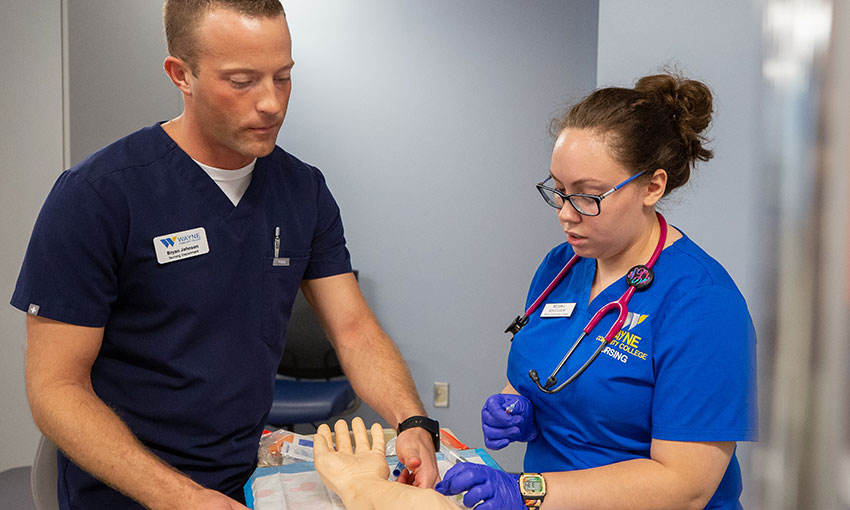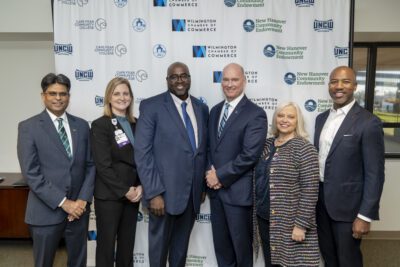
|
|
Wayne Community College is getting a new clinical nursing instructor thanks to a partnership with UNC Health Wayne. The local hospital will be paying for the salary and benefits of one clinical nursing instructor for the college for a five year period. The college hopes this partnership will help address two challenges with one program — bolstering enrollment and addressing the nursing shortage.
The nationwide nursing shortage has only gotten worse since the pandemic. If trends continue, North Carolina is forecasted to be among the top five states for nursing shortages by 2026. According to N.C. Nursecast data, the state could face a shortage of an estimated 17,500 nurses by 2033, made up of 12,500 registered nurses (RNs) and around 5,000 licensed practical nurses (LPNs).
Wayne Community College’s relationship with UNC Health Wayne spans decades. The hospital has been the first choice for clinical site placements for the college’s nursing program students, and thy end up hiring the majority of the nursing program graduates. Last year, UNC Health Wayne hired between 75-80% of Wayne Community College’s nursing class.
“It has been a longstanding relationship and a strong relationship,” said Dr. Patricia Pfeiffer, president of Wayne Community College. “This partnership shows the mutually important relationship education, business, and industry have to meet workforce demands.”
In 2019, the hospital paid for a clinical nursing instructor for the college for two and a half years after the hospital requested that the college increase spots in their nursing program. The impact of the pandemic, however, made it challenging to assess the effectiveness of this partnership. Wayne, along with many community colleges, experienced lower enrollment and completion rates during the pandemic. Even so, the program was positive for both parties, Dr. Pfeiffer said, and they decided to pursue a five-year contract.
Sign up for Awake58, our newsletter on all things community college.
In addition to securing a new clinical nursing instructor, Wayne is also working on an apprenticeship program that they are hoping will have a profound impact on both their students and the greater community. The new program will allow licensed practical nurses (LPNs) to work towards their registered nursing (RN) license while working and in school. The hospital will then reimburse program participants for the coursework.
“The apprenticeship program will be a game changer for them,” said Dr. Pfeiffer.
The college started thinking about a nursing apprenticeship program five years ago. At the time, they had apprenticeship programs for other industries, but none in health care.
Wayne started their first health care apprenticeship program in 2022 with a one-year sterilization technician program. Since then, they have been working towards creating other apprenticeship programs with a focus on local industry needs.
“This partnership allows Wayne CC and Wayne UNC Health to strengthen support for our students and the community. This provides our students with opportunities that otherwise may not be possible. Our collaboration will assist in improving the quality of education and improve student outcomes as well as show the support we offer to our community and local health care.”
Michelle Garon, nursing department chair at Wayne Community College
The college was inspired by the apprenticeship model used by Surry-Yadkin Works, a collaborative internship program that connects students, businesses, educational entities, and government, as well as health care apprenticeships at Davidson-Davie Community College.
“We looked at other models and what other people were doing in the state,” said Kristie Sauls, executive director of apprenticeships and career development at the college. “I’m always looking at what my counterparts are doing.”
Having helped 350+ students secure internships and other opportunities since its inception, Surry-Yadkin Works has become a model for other colleges. Surry-Yadkin Works was one of the first in North Carolina to offer a youth apprenticeship program for licensed practical nursing and registered nursing.
“Enrollment has been down for several years in higher education and the pandemic didn’t help that, but people have to work. We need a paycheck,” said Sauls. “Apprenticeships allow for that income mobility to happen that employees didn’t know could happen.”
The new nursing apprenticeship program is expected to begin this summer or fall.
“There are many ways we can team up,” said Pfeiffer. “This is a prime example of working hand-in-hand to meet the needs of not only the workforce, but the community.”
Recommended reading




